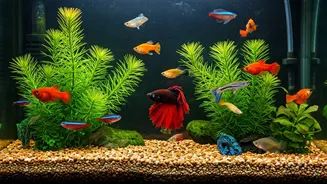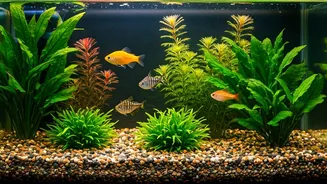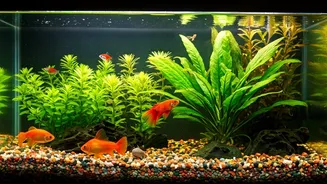Neon Tetra's Allure
Neon Tetras are a dazzling choice for newcomers to the aquarium hobby, bringing vibrant color and a peaceful presence to any tank. These small, schooling
fish are known for their striking blue and red stripes that illuminate the aquarium. They are generally adaptable and can thrive in a well-maintained environment. Proper care involves providing a tank size of at least 10 gallons to allow for adequate swimming space and the establishment of a stable aquatic environment. They prefer slightly acidic water with a pH range of 6.0 to 7.0 and a water temperature between 72°F and 78°F (22°C to 26°C). Regular water changes are critical to maintaining water quality, and a good filtration system helps remove waste and toxins. Neon Tetras are omnivores, readily accepting flakes, pellets, and small live or frozen foods. A balanced diet prevents health issues and promotes vibrant coloration. Neon Tetras' peaceful temperament makes them suitable tank mates for other small, non-aggressive fish, making them an excellent choice for a community aquarium.
Guppy's Easy Living
Guppies are another excellent choice for beginners, celebrated for their vibrant colors, ease of care, and ability to adapt to a wide range of water conditions. These live-bearing fish are incredibly prolific, making them a fascinating addition to a beginner's aquarium. They can thrive in a tank of 10 gallons or more, providing ample space for swimming and reproduction. Guppies prefer a pH range of 6.8 to 7.8 and a water temperature between 72°F and 82°F (22°C to 28°C). Regular water changes are essential to maintain the cleanliness and health of the tank, preventing the buildup of harmful substances. Guppies are omnivores and readily consume various foods, including flakes, pellets, and live or frozen options. A varied diet contributes to their vibrant colors and overall health. Their peaceful nature allows them to coexist well with other community fish species that share similar requirements, creating a colorful and dynamic aquarium environment.
Mollies' Resilience
Mollies are a robust and adaptable species, making them suitable for beginners who want a hardy and visually appealing fish. These fish come in various colors and fin shapes and are known for their active swimming behavior. Mollies thrive in tanks of at least 20 gallons, which provides enough room for their active nature. They prefer a pH of 7.5 to 8.5 and a temperature range of 72°F to 82°F (22°C to 28°C), adapting to harder water conditions. Maintaining a clean environment through regular water changes and effective filtration is vital for their well-being. Mollies are omnivores and readily accept a variety of foods, including flakes, pellets, and algae-based foods, which support their health and vibrancy. Their relatively peaceful nature makes them suitable for community aquariums with similarly tempered fish. Offering a balanced diet and a spacious environment promotes their health and stunning appearance.
Betta Fish Beauty
Betta fish, also known as Siamese fighting fish, are striking, visually appealing fish often kept by beginners. Betta fish are known for their flamboyant fins and diverse colors. They are generally territorial and should ideally be kept alone in a tank to avoid aggression; a 5-gallon tank or larger is the perfect size. They thrive in a water temperature between 76°F and 82°F (24°C to 28°C) and a pH of 6.5 to 7.5. Regular partial water changes and filtration are essential to maintain water quality and prevent health problems. Betta fish are carnivores and need a diet of high-quality betta pellets, supplemented with live or frozen foods like bloodworms or brine shrimp. Since they are surface feeders, it's best to feed small portions. Betta fish are best kept alone; compatibility with other species can be tricky due to their territorial nature.
Zebra Danio's Charm
Zebra Danios are a great choice for beginner aquarists because they are energetic, active fish and add a sense of movement to an aquarium. These small fish are identifiable by their horizontal stripes, which are similar to a zebra's markings. They thrive in schools of six or more and are suited for a tank size of 10 gallons or larger, which allows them to swim freely. Zebra Danios adapt to a wide range of water conditions, preferring a pH of 6.0 to 8.0 and a temperature range of 64°F to 74°F (18°C to 23°C). Regular water changes and a good filtration system are important to maintain water quality, and they are quite tolerant to variations in water parameters. Zebra Danios are omnivores that happily eat various flake foods and small pellets, supplemented by live or frozen treats. Their peaceful disposition makes them excellent community fish, fitting well with other gentle species.








